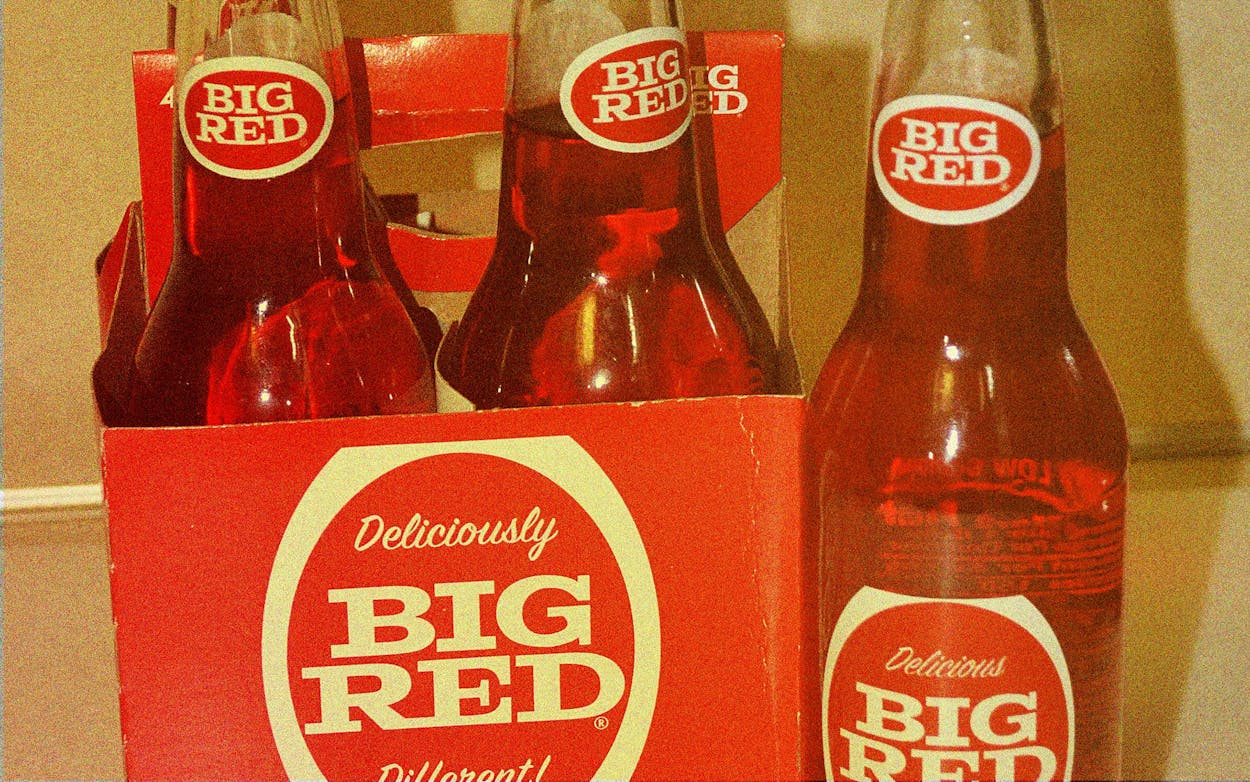I had my first sip of Big Red this year, at age 31, not with barbacoa, as is recommended, but with Impossible “Chicken” Nuggets during a hastily thrown-together lunch.
I’ll be honest, I’m not a good Texan—though I spent much of my childhood here, I was tainted by my time living in the Pacific Northwest. I’m a pescatarian and languish even in 85-degree weather. Mosquitos treat me like a buffet. I don’t own cowboy boots. And my go-to “soda” is an ashwagandha-blackberry “Adaptonic” with six grams of sugar that I should probably get bullied for (head to the comment section below). But, upon hearing that I had never tried Big Red, my editor thought I should give it a good ol’ Texas try.
I waited so long to take my first sip of Big Red after agreeing to write this that it began to feel as if I were preparing for a marathon or anticipating a holy ritual. Part of that lead-up involved asking a few people, Texas natives and nonnatives, whether they’d had it before. Michael Zumaya, a Los Angeles transplant in Austin, said of course he had, and when asked what it tastes like, he said, cryptically, “You drink it and you’re still drinking it a year later.” A Galveston native, Shane Greb, said, “It tastes like red.” A Houston native and brewer at Saint Arnold Brewing Company, Will Kremer, said something that Big Red might want to include in a commercial: “Robert Earl Keen was right; that sugary bubble gum–vanilla flavor is something that pairs perfectly with the salt and pepper of Texas barbecue.” My friends farther afield were mystified. One who lives in Washington state texted back, “The gum?”
With these interpretations in mind, I consulted the internet: Big Red’s flavor is often described as either cotton candy or bubble gum, though the original formulation included lemon and orange oils added to the traditional vanilla of cream soda. In fact, the beverage, invented in Waco in 1937, originally had the lengthy moniker “Sun Tang Red Cream Soda.” Descriptive, but not as catchy as Big Red, which became the name after an executive heard two caddies refer to it as such. It was originally only sold in Texas and Louisville, Kentucky, and its somewhat cultish following is still primarily Texas-based (though some New Yorkers seem to really enjoy it).
Texas Monthly’s brand bracket competition also includes Dr Pepper, which is not only a Texas brand but also a Waco brand (what was going on in that town?), though it precedes Big Red by about fifty years. In fact, Big Red became part of Keurig Dr Pepper’s (then Dr Pepper Snapple) “family of brands” in 2008, meaning it’s now sold all over the country. Dr Pepper is my go-to soda if I’m having one. One of my first memories, even, is of the night I tried my first soda, a sip of my dad’s Dr Pepper, in our dimly lit kitchen in Sugar Land. At the time, I scrunched up my face and my eyes watered from the carbonation, but Dr Pepper would go on to be my favorite once my palate was able to handle it.
And after finally tasting my first sip of Big Red, I’m sorry to tell all its hard-core fans . . . Dr Pepper is still in the lead. Big Red really does “taste like red” to me—and by that, I mean it tastes more like liquefied red Jolly Ranchers than it does any distinct natural flavor. Meanwhile, Dr Pepper is over here with its 23 secret flavors, the most apparent to me being prune or plum and maybe a bit of clove. That said, I can totally understand the draw of Big Red alongside spicy meat—it has a particular soothing smoothness that would be refreshing with something other than my fake chicken nuggets (I’m sorry). San Antonio even has an entire festival dedicated to the consumption of barbacoa alongside Big Red. And perhaps I would enjoy the soda more in alcohol or dessert form—Big Red is an adaptable ingredient.
I think if I’d tried Big Red as a kid—back when I looked forward to my after-school can of also-very-saccharine A&W cream soda—I would have loved it. But for now, I’m afraid my bad Texan heart belongs to Adaptonics (or to the sugar-free, supercrisp, Texan-friendly option: Rambler). Unless there’s a Dr Pepper around.






